![]()
![]()
![]()
Use LEFT and RIGHT arrow keys to navigate between flashcards;
Use UP and DOWN arrow keys to flip the card;
H to show hint;
A reads text to speech;
200 Cards in this Set
- Front
- Back
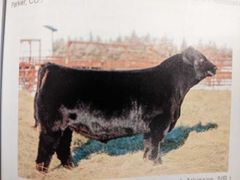
|
Angus |
|
|
Angus |
Black, Scotland, marbled |
|
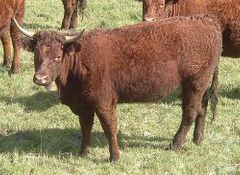
|
American Salers |
|
|
American Salers |
Mahogany red, France, good foraging on poor range |
|
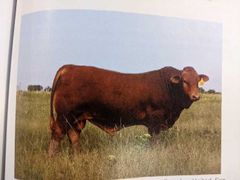
|
Beefmaster |
|
|
Beefmaster |
Texas, Hereford/Shorthorn/Brahmans, drooping ears and loose hide |
|
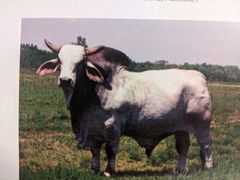
|
Brahman |
|
|
Brahman |
SW USA, drooping ears, loose hide, pendulous sheath, hump |
|
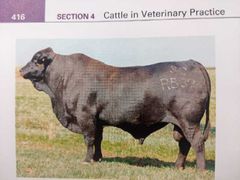
|
Brangus |
|
|
Brangus |
Brahman/Angus, USA, polled, drooping ears and loose hide, bulls have small hump, adapt well to different climates |
|
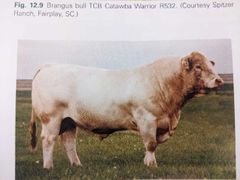
|
Charolais |
|
|
Charolais |
Light straw with pink skin, France, large and heavily muscled, horns |
|
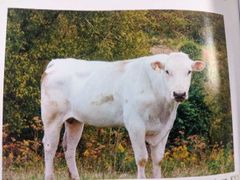
|
Chianina |
|
|
Chianina |
White/grey with black skin & switch, Italy, up to 4000lbs, high heat and disease tolerance |
|
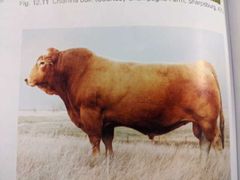
|
Gelbvieh |
|
|
Gelbvieh |
Red/russet with dark skin and hooves, W Germany |
|
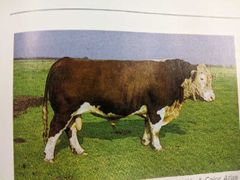
|
Hereford |
|
|
Horned & Polled Herefords |
Red body, white face & ventral, England |
|
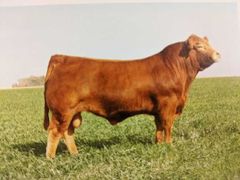
|
Limousin |
|
|
Limousin |
Mahogany red with light tan ventral & muzzle & legs, France, small & short head, short neck, lean & large loin |
|
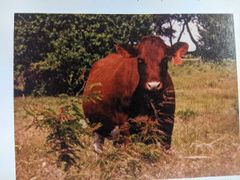
|
Maine-Anjou |
|
|
Maine-Anjou |
Dark red with white ventral & spots, France, lightly pigmented skin, marbled |
|
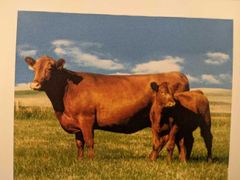
|
Red Angus |
|
|
Red Angus |
Red recessive, USA, 1945, tolerate warmer temps otherwise like Black Angus |
|

|
Santa Gertrudis |
|
|
Santa Gertrudis |
Cherry red, Texas, Brahman bull/Shorthorn cow, hair different lengths based on weather, resist disease & insects |
|
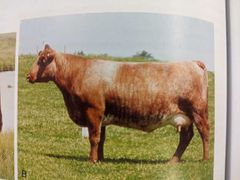
|
Shorthorn |
|
|
Shorthorn |
Red/white/roan, England, cross well |
|
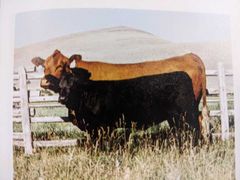
|
Simmental |
|
|
Simmental |
Switzerland, horns, rapid growth, no excess fat |
|
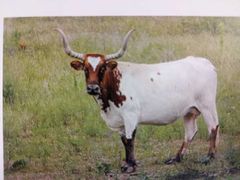
|
Texas Longhorn |
|
|
Texas Longhorn |
1000lbs, Spain, many shades/colors, horns curve upward 4ft+, long legs & high shoulders, hair btw horns |
|
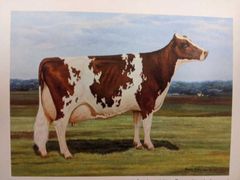
|
Ayrshire |
|
|
Ayrshire |
Dairy- Red/mahogany/brown, Scotland, well-balanced udders attached high caudal and extend, 3rd avg milk production, 4th avg milk fat |
|
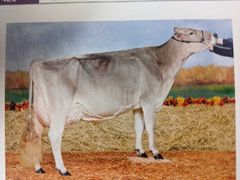
|
Brown Swiss |
|
|
Brown Swiss |
Dairy- brown with black nose & tongue, large-framed and docile, 2nd avg milk production, 3rd avg milk fat |
|
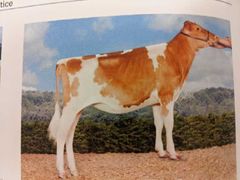
|
Guernsey |
|
|
Guernsey |
Dairy- Isle of Guernsey, fawn with white, early-maturing, golden milk, 4th avg milk production, 2nd avg milk fat |
|
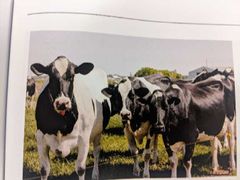
|
Holstein-Fresian |
|
|
Holstein-Friesian |
Dairy- black and white, Netherlands, red recessive, largest of dairy breeds 1500-2200, bulls aggressive, 1st avg milk production 14,500lbs, 5th avg milk fat 3.5% |
|
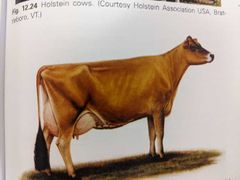
|
Jersey |
|
|
Jersey |
Dairy- cream/light fawn/almost black, Isle of Jersey, smallest 1000-1600lbs, bulls aggressive, 5th avg milk production 10,000lbs, 1st avg milk fat 5.4% |
|
|
Crossbreeding |
Mating sires of one breed to dams of another, increases heterosis and diversity |
|
|
Grading up |
Mating of a nondistinctive animal to a purebred |
|
|
Mutation and traction |
Method to resolve dystocia, reposition and pull |
|
|
Fetotomy |
Method to resolve dystocia, fetus is dead, amputate and remove parts |
|
|
C section |
Method of treating dystocia, if trauma of vaginal birth outweighs risk of surgery |
|
|
Pen mating |
Group of males and females left in a pen to mate naturally. Aka harem mating, less males than females |
|
|
Hand mating |
1 male and 1 female in estrus, watched for mating |
|
|
Individual breeding |
1 female and 1 male left unsupervised, assumed to mate eventually once female is in estrus |
|
|
Non-ruminants? |
Horses and swine |
|
|
Ruminants |
Cattle, sheep, goats |
|
|
Modified ruminants |
Llamas and alpacas |
|
|
What does the large intestine do during digestion? |
Water absorption, mucous production |
|
|
What does the small intestine do during digestion? |
Chyme mixes with pancreatic juices, bile, and intestinal juices for digestion of proteins, starch, and fat |
|
|
What does the cardiac do during digestion? |
Connects esophagus to stomach |
|
|
What does the pancreas do during digestion? |
Secretes pancreatic juices |
|
|
Dry Roughages/Forages |
Cut and cured plants to be fed year-long, >18% crude fiber |
|
|
Pasture plants |
Uncut Roughages, eaten directly, 18% crude fiber |
|
|
Energy feeds |
High total digestible energy feeds, ie cereal grains, sorghum, by-products, <18% crude fiber <20% protein |
|
|
Alfalfa |
Type of clover (legume) proteinaceous roughage, can cause bloat |
|
|
Hay |
Type of proteinaceous roughage, can be combined grasses or hay sp |
|
|
Straw |
Type of carbonaceous roughage, usually bedding but can be low protein diet |
|
|
Stocks |
Type of carbonaceous roughage, utilized for winter grazing, low protein |
|
|
Corn |
Cereal grain energy feed, most common |
|
|
Oats |
Cereal grain energy feed, very palatable |
|
|
Barley |
Cereal grain energy feed, less palatable and can be infected by ergot fungus |
|
|
Wheat |
Cereal grain energy feed, less common due to high human demand |
|
|
Rye |
Type of cereal grain energy feed, low palatability and can have ergot fungus |
|
|
Triticale |
Type of cereal grain energy feed, combination of wheat and rye |
|
|
Sorghum |
Type of energy feed, drought-resistant, should be processed for maximum digestibility |
|
|
Molasses |
Energy feed, by-product from sugar beets and sugar cane |
|
|
Silages |
Green forage (corn, sorghum, alfalfa, clover) compressed and stored in silo with no oxygen to be fermented, long-term storage |
|
|
Feeding barn and dry lot |
Cattle fed inside barn, otherwise outside |
|
|
Open barn and dry lot |
Some shelter provided and cattle fed using fence line feeders |
|
|
Open dry lot |
Utilizes wind breaks or natural shelters, not pasture! |
|
|
Grade A |
Eligible for fluid use Raw milk cooled to 45F or less within 2hrs, after blending can't be over 50F Bacteria <100,000 per mL, after blending <300,000 Somatic cells <750,000 per mL No antibiotics detectible
|
|
|
Grade B |
Manufacturing milk Bacteria <500,000 per mL Somatic cells <750,000 per mL No drug residues present |
|
|
Pasteurization |
Process of heating and cooling repeatedly to remove bacteria |
|
|
Milk fat amounts |
Whole milk 3.25% Low-fat 0.5-2% Skim <0.5% |
|
|
Pepsin |
Stomach enzyme, breaks down proteins |
|
|
Trypsin |
Small intestine enzyme, breaks down protein |
|
|
Pancreatic amylase |
Small intestine enzyme, breaks down starch to maltase |
|
|
Lipase |
Small intestine enzyme, breaks down fats into fatty acids and glycerol |
|
|
Gallbladder |
Houses bile, which helps break down fats and fatty acids |
|
|
Salivary amylase |
Mouth enzyme, breaks starch down into maltase |
|
|
Salivary maltase |
Mouth enzyme, breaks maltase to glucose |
|
|
Ruminant path of feedstuffs through stomach |
Rumen, reticulum, omasum, abomasum |
|
|
Septic mastitis in a cow |
Bacterial infection of udder, most common from bacteria ascending the streak canal/test orifice when open for milking. Clean teat only! |
|
|
Cow |
Mature female |
|
|
Heifer |
Immature female |
|
|
Bull |
Mature male |
|
|
Steer |
Castrated male |
|
|
Calf |
Neonate |
|
|
Calving |
Parturition |
|
|
Heifer calf |
Neonate female younger than 1 yo |
|
|
Bull calf |
Neonate male younger than 1 |
|
|
Bovine TPR |
Temp 100-102.5 Pulse 40-80 bpm Resp 10-30 bpm |
|
|
Estimated Progeny Differences |
Predicting characteristics of offspring, males only |
|
|
Estimated breeding values |
EPDs plus heritability |
|
|
Conformation |
Physical traits |
|
|
Pedigree |
Performance traits of an animal's ancestors |
|
|
Estrous Cycle order |
Proestrus, Estrus, Metaestrus, Diestrus (anestrus only during pregnancy) |
|
|
Proestrus |
Follicle stimulating hormone causes development of follicles in the ovary |
|
|
Estrus |
Luteinizing hormone causes the follicle to rupture, triggering ovulation |
|
|
Metaestrus |
The ruptured follicle becomes the corpus luteum |
|
|
Diestrus-no pregnancy |
Prostaglandin levels surge, causing lysis of the corpus luteum |
|
|
Diestrus-pregnancy |
Progesterone is produced until gestation |
|
|
Progesterone |
Hormone produced by the corpus luteum, maintains pregnancy |
|
|
FSH |
Follicle-stimulating hormone, causes follicular development and estradiol synthesis |
|
|
LH |
Luteinizing hormone, stimulates ovulation and formation of corpus luteum |
|
|
Prostaglandin |
Hormone that causes regression of the corpus luteum |
|
|
A heifer should be at what percent of mature cow weight before breeding? |
60-65% |
|
|
A breeding soundness exam if males emphasizes |
Vision and conformation (factors can create variation in scrotal size) |
|
|
Phenothiazine-based tranquilizers |
Used to examine males external genitalia, helps with prolonged penile extension |
|
|
Hemocytometer |
Determines sperm concentration |
|
|
Methods of semen collection |
Electroejaculation, artificial vagina, or natural stimulation |
|
|
Pregnancy detection in cattle and horses |
Rectal palpation |
|
|
Pregnancy detection in sheep and goats |
Transabdominal ultrasound |
|
|
Pregnancy detection in swine |
Transabdominal ultrasound |
|
|
Oxytocin |
Hormone that is responsible for uterine contractions |
|
|
Meconium |
First stool passed by newborn, dark, should pass within 12 hours of birth |
|
|
Order of neonatal care after birth? |
Oxygen- temp- umbilical- nursing- bonding- meconium- antibodies- exam |
|
|
What happens in the rumen? |
Microbial digestion by bacteria and protozoans |
|
|
What happens in the reticulum? |
Grinding of feed material |
|
|
What happens in the omasum? |
Function unknown, thought to contribute to grinding and removing water |
|
|
What happens in the abomasum? |
True stomach, gastric acid breaks down food |
|
|
Lipids |
Sources of heat and energy, carry fat-soluble vitamins A D E K |
|
|
Carbohydrates |
Simple sugars held together by glycosidic bonds, energy source |
|
|
Water-soluble vitamins |
B-complex, C, also K (fat-soluble) synthesized by rumen when healthy, |
|
|
Thiamine deficiency result |
Blindness, heart irregularities, convulsions, death |
|
|
Folic acid and riboflavin deficiency results |
Anemia, diarrhea, poor growth |
|
|
7 macrominerals |
Calcium & phosphorus, sodium & chloride, magnesium, sulfur, potassium |
|
|
Ergot |
Black fungus that reduces blood supply to the extremities, resulting in necrosis of the lower limbs; tail and ear tips also become necrotic |
|
|
Identifying nutritional requirements |
Find maintenance requirements, then add nutrients based on function |
|
|
Determining feeds |
Look at type of digestive system, amount of feed an animal can consume, and best feeds available |
|
|
Total body water |
60% intracellular 30% extracellular (plasma & lymph) 10% transcellular (body cavities) |
|
|
Maintenance fluids needed calc |
2-4 mL/kg/hour |
|
|
5% dehydration |
HR 28-40 CRT <2 PCV wnl |
|
|
6-7% dehydration |
Mild: HR 40-60 CRT 2 PCV 40/7 skin tent 2-3 seconds |
|
|
8-9% dehydration |
Moderate: HR 61-80 CRT 3 skin tent 3-5 seconds tacky mm |
|
|
10-11% dehydration |
Severe: HR 81-100 CRT 4 PCV/TS 50/8 weak pulse, tent >5 s |
|
|
Deficit replacement |
Kg x % dehydration |
|
|
Max fluid rate for potassium chloride |
1 mEQ/kg/hr |
|
|
Enteral nutrition |
GI support: nasogastric tube and liquid diet |
|
|
Parenteral nutrition |
IV support- partial or total based on calculated nutritional needs |
|
|
Lactation Cycle Phase 1 |
Calving makes milk production climb rapidly. Metabolic diseases (ketosis) common during this phase |
|
|
Lactation Cycle Phase 2 |
Feed intake adequately matches milk production, lost weight is regained. |
|
|
Lactation Cycle Phase 3 |
Dry matter consumption declines as milk production steadily declines |
|
|
Lactation Cycle Phase 4 |
Dry phase, good nutrition to prep for next calf, ideal BCS |
|
|
Freshening |
Calving/kidding/parturition |
|
|
Seed stock producers/ Purebred Breeders |
Beef industry, raise cattle for genetic enhancement |
|
|
Cow/calf producers |
Beef industry, raise calves for sale to feedlots |
|
|
Stocker feeders |
Beef industry, lighter calves given a high-roughage diet through winter |
|
|
Feedlots |
Beef industry, grow cows for harvest |
|
|
Quality grade vs yield grade |
Quality: amount and coverage of finish, muscles Yield: fat coverage |
|
|
Farrowing |
Parturition in swine |
|
|
Most common cause of piglet death |
Crushing by the sow |
|
|
Mohair |
Goat fiber Llama, alpaca, sheep fiber is wool |
|
|
Anthrax |
Splenic fever, bacterial, zoonotic, reportable |
|
|
Brucellosis |
Bang disease, bacterial, causes abortion, shed in repro fluids, zoologic (ungulate fever), reportable |
|
|
Calf enteritis |
Scours, bacterial, major cause of death in the first few weeks of life |
|
|
Johne disease |
Para tuberculosis, mycobacterial, fecal-oral, silent stage, reportable, zoonotic (Chrone's disease), no tx |
|
|
Leptospirosis |
Bacterial, zoonotic, reportable |
|
|
Mastitis |
Inflammation of mammary gland, bacterial, clinical and subclinical |
|
|
Metritis |
Inflammation of uterus |
|
|
Shipping fever |
Pasteurellosis, bacterial, upper respiratory bacteria cause cough |
|
|
Tuberculosis |
Bacterial, granulomatous disease,reportable |
|
|
Vibriosis |
Venereal bacterial disease, clinical signs often absent |
|
|
Wooden tongue |
Actinobacillosis, bacterial, abscesses of tongue from upper GI bacteria |
|
|
Bovine Spongiform Encephalopathy (BSE) |
Mad cow disease, abnormal protein (prion), reportable, infected meat |
|
|
Dermatophytosis |
Ringworm, fungal, itchy lesions, self-resolves |
|
|
Trichomoniasis |
Protozoal, venereal disease, effects repro, bulls infected for life, reportable |
|
|
Bovine Respiratory Syncytial Virus |
RNA virus, replicates in lower respiratory tract, predisposes to secondary bact infection |
|
|
Bovine virus diarrhea |
Transmitted by secretions, excretions, or fetally, causes reabsorption or carrier, ulcerated lesions, reportable |
|
|
Foot & Mouth disease |
Viral, Highly contagious, foreign, fatal, lesions, reportable |
|
|
Infectious Bovine Rhinotracheitis |
Red nose, caused by bovine herpes virus 1, reportable |
|
|
Fatty liver disease |
Over conditioning at parturition, triglycerides build up in liver |
|
|
Hardware disease |
Foreign body ingestion, penetrates abomasum |
|
|
Hypocalcemia |
Milk fever, low calcium from milk production |
|
|
Hypomagnesemic Tetany |
Grass Tetany/ Grass Staggers, low magnesium in blood, death |
|
|
Intersexuality |
Hermaphrodite, Freemartinism common in cattle, female with male twin develops abnormal internal genitalia |
|
|
Abomasal volvulus |
Rotates on mesenteric axis |
|
|
Polio encephalomalacia |
PEM, thiamine deficiency from abnormal rumen fermentation causes neurologic disease |
|
|
Listeriosis |
Bacterial, from contaminated silage or rodents, facial nerve paralysis |
|
|
Blackleg |
Bacteria in muscles, found dead |
|
|
Laminitis |
Founder, any changes to the corium of the hoof |
|
|
Urolithiasis |
Formation of urinary stones in bulls, caused by high-grain diets and stones can obstruct sigmoid flexure |
|
|
Alkaloid toxin |
Liver disease |
|
|
Urea toxin |
Ruminal tympany |
|
|
Photosensitizing agent toxin |
Dermatological |
|
|
Cyanogenic toxin |
Dyspnea |
|
|
Lead toxin |
Blindness |
|
|
Nitrate toxin |
Vitamin a deficiency |
|
|
Mycotoxins |
Reduced feed intake |
|
|
Saponin toxins |
V/d |
|
|
Tannin toxins |
Anorexia |
|
|
Cattle puberty |
7-18mo |
|
|
Cattle permanent dental formula |
2(I0... no incisors! |
|
|
Healthy, mature cattle drink how much water? |
10-14 gallons daily |

